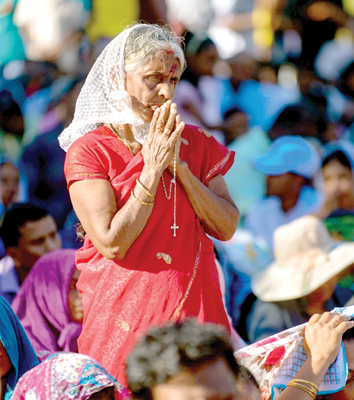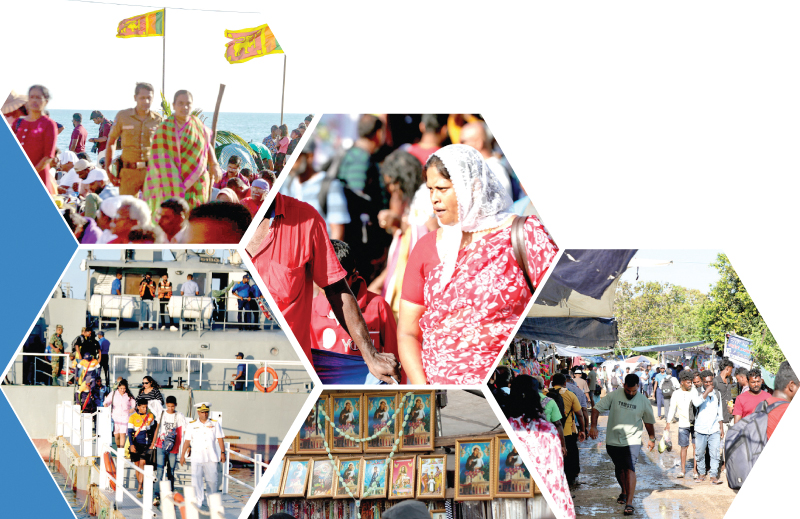 Katchatheevu is a small, uninhabited island between India and Sri Lanka in the Palk Strait. Though it spans just 1.15 square kilometres, it has a rich history shaped by colonial rule, diplomatic agreements and strong cultural ties.
Katchatheevu is a small, uninhabited island between India and Sri Lanka in the Palk Strait. Though it spans just 1.15 square kilometres, it has a rich history shaped by colonial rule, diplomatic agreements and strong cultural ties.
For generations, fishermen from Tamil Nadu (India) and northern Sri Lanka have used its waters for their livelihood, making it a neutral meeting point. The island’s name comes from the Tamil words Katchal (barren) and Theevu (island), reflecting its rocky, uninhabitable nature.
Once part of the Ramnad Kingdom in India, Katchatheevu’s ownership was unclear during British rule. In 1974, India officially handed it over to Sri Lanka through a bilateral agreement under Prime Minister Indira Gandhi. While this settled the territorial dispute, concerns over Indian fishermen’s traditional fishing rights remain.
Despite its political history, Katchatheevu is best known for its spiritual significance. The island is home to St. Anthony’s Church, a 120-year-old shrine built by Tamil fishermen. Dedicated to St. Anthony of Padua, the patron saint of seafarers, it stands as a symbol of faith and unity. Each year, thousands of pilgrims from India and Sri Lanka gather here for a two-day festival, setting aside borders to celebrate their shared traditions.
The 2025 Katchatheevu Church Festival is a unique event. It is the only time of the year when people can visit the island without a passport or visa. Outside these two days, only the Sri Lankan Navy is stationed there. During the festival, the island comes alive with religious services, cultural events and social gatherings, creating an atmosphere of devotion and togetherness.
This article attempts to capture the essence of the festival, offering a first-hand look at its religious significance, cultural vibrancy and the deep connections it fosters between two nations.
Journey to Katchatheevu
The writer’s journey to Katchatheevu began at the Kurikkattuwan Jetty in Jaffna, a bustling gateway filled with anticipation. On arrival, one could witness Sri Lanka Transport Board (SLTB) buses from Colombo pulling in, alongside hundreds of private vehicles and buses parked in the vicinity. The air buzzed with conversations as locals said that most pilgrims had begun their journey in the early morning.
A long queue stretched before us, leading to the boats bound for Katchatheevu. We waited patiently for nearly two hours, watching people steadily move forward. The Sri Lanka Navy and Delft Divisional Secretariat officials meticulously recorded each passenger’s details before allowing them to board. Finally, life jackets were handed out and passengers stepped onto the boat, greeted by the sea’s rhythmic sway.

Pix by Shan Rupassara and Sakuna Gamage
There were around 50 to 60 passengers on board, all strangers at first. Unlike the familiar hum of buses and trains, this was a different kind of journey a voyage into the sea. For many including the writer’s it was the first time travelling in a boat across open waters. As the vessel slowly pulled away from the shore, we caught glimpses of the Nainativu (Nagadeepa) and Delft Island in the distance. The initial silence gave way to conversations, laughter and shared excitement as the group became fellow travellers on the same pilgrimage.
By the time one reached Katchatheevu, it was 3 p.m. The sight before us was breathtaking: hundreds of boats anchored in the distance, their colourful hulls bobbing on the waves. The air carried the scent of the sea, mingling with the distant sounds of prayer and celebration from St. Anthony’s Church. The Indian flag fluttered proudly on several boats, while on the other side of the island, Sri Lankan flags soared high as if extending a warm welcome to all visitors.
The Sri Lankan Navy helped pilgrims and other visitors to enter the island, ensuring everyone’s safety as they stepped onto this historic land. The first stop was the registration of pilgrims, as everyone was handed a coupon for that evening’s dinner and the following day’s breakfast. Then, we began our walk inland, eager to witness the unfolding festival.
An island transformed
Katchatheevu, usually a barren and desolate place, had been transformed. Newly paved paths, water tanks and electric lights had been installed, illuminating the island for the thousands who had arrived. People disembarked from their boats, carrying large bundles of supplies, while others were busy pitching tents or clearing the docks in preparation for the celebrations.
Under the scorching afternoon sun, we spotted a small shop selling cold, juicy oranges a welcome sight for weary travellers. The prices differed: 50 Indian rupees or 150 Sri Lankan rupees. The shop owner, a Sinhalese from Anuradhapura, greeted us warmly, handing over chilled drinks with a smile. “Just one thing,” he cautioned, “don’t wander into the forest at night – there are dangerous snakes.” Refreshed and re-energised after sipping on the cold orange juice, we continued deeper into the island, eager to experience the heart of the Katchatheevu Festival.
Confluence of cultures and communities
As one ventured further into Katchatheevu, a common question echoed among the pilgrims, “Where are you from?” This simple inquiry unveiled the island’s unique tapestry of cultures and communities. Fishermen from Sri Lankan locales such as Jaffna, Talaimannar and Point Pedro mingled with their Indian counterparts from Rameswaram, Karaikal, and Nagapattinam. The island had transformed into a vibrant mosaic of traditions and stories, each pilgrim adding their hue to the Festival’s rich palette.
Anchored around Katchatheevu were numerous Indian trawler fishing boats, their presence highlighting the complex dynamics between the two nations’ fishing communities. These trawlers, often at the heart of disputes due to allegations of illegal fishing in Sri Lankan waters, stood in stark contrast to the spirit of unity pervading the festival. Notably, the Sri Lankan Navy, frequently accused by Indian fishermen of arrests and confrontations, had assumed the role of gracious hosts. They provided essential amenities to worshippers, safeguarded the moored Indian vessels and assisted elderly devotees in disembarking, ensuring their safe passage onto the island.
In a conversation, Lieutenant Commander Kasun Vimukthi shed light on the Navy’s dedication to the festival, he said, “I haven’t slept for almost a week. For the past month, several hundred Navy personnel have been working hard to prepare the island for the festival. We’ve built pathways and set up drinking water facilities, temporary toilets, bathing areas and medical centres. We’ve also arranged food for worshippers. Every year, the Sri Lanka Navy takes on this responsibility with pride, as this festival is a gazetted religious event in Sri Lanka. While there are challenges, we do our best to overcome them and ensure everything runs smoothly. So far, 8,500 devotees have arrived today, more than we expected. For safety reasons, we won’t allow any more arrivals after 6:00 pm.”
The collaborative efforts of the Navy and the festival committee, especially the Delft Divisional Secretariat, ensured that all necessary facilities, including food and beverages, were available to the pilgrims.
Harmonious blend of commerce, culture and spirituality
The Katchatheevu Festival’s vibrant atmosphere is reminiscent of other Sri Lankan festivals, with small stalls lining the pathways. However, the goods offered and the nature of transactions here is uniquely influenced by the island’s position between the two nations. Both Sri Lankan and Indian currencies are accepted seamlessly, with an exchange rate reflecting the relative values: Sri Lankan Rs. 15 equates Indian Rs. 5. Vendors from both countries set up shop, offering a wide array of items from traditional attire to delectable foodstuff.
One interesting observation was the prominence of Rani soap in many Sri Lankan stalls. Curious about its popularity, the writer approached Muthathalaghi, a vendor from Jaffna.
“Fishermen from India love Sri Lankan Rani soap. They always buy and ask for it every year. They also love Sri Lankan tinned fish. So, we bring them here from Jaffna and sell them. We sell a piece of Rani soap for Indian Rs. 50,”
Indians eagerly purchased Sri Lankan sweets such as Boondhi and Murukku, while Sri Lankan attendees relished authentic Indian paratas and curry. It was common to see Indians savouring popular Sri Lankan instant noodles, just as Sri Lankans enjoyed traditional Indian chai.
Amidst the festive commerce, the spiritual essence of the event shone brightly. Devotees from both nations participated in worship without distinctions of race, language, or nationality. The majority hailed from fishing communities, unified in their faith. The presence of religious leaders, from the Bishop of Jaffna to visiting Bishops from Tamil Nadu, leading the ceremonies underscored the festival’s embodiment of multicultural harmony. The Katchatheevu festival stands as a testament to the enduring bonds between neighboring communities, where commerce, culture and spirituality intertwine, transcending geopolitical boundaries.
Fishermen’s tales amidst the Festival lull
As midnight approached, the vibrant energy of Katchatheevu gradually gave way to a serene calm. Approximately 8,500 pilgrims found rest across the island, their mats and tents scattered along the shoreline. The gentle sea breeze, rhythmic waves and a luminous full moon overhead created a tranquil ambience.
In this quiet setting, the writer met Karuna, a 27-year-old fisherman from Tamil Nadu. As he prepared his sleeping area beside me, our conversation naturally drifted towards the longstanding fishing disputes between India and Sri Lanka. Soon, Natarajan, a journalist from BBC Tamil Nadu, joined our discussion, enriching it with his insight.
Karuna shared his personal experiences, shedding light on the challenges faced by fishermen from his region. “I’ve been fishing for almost 12 years. There is no fish left in our sea. We only find a good catch when we enter the Sri Lankan waters. Without doing so, our families would starve. Various reasons have depleted our sea resources and the ceding of Katchatheevu to Sri Lanka is one of them.”
He expressed concerns about the methods employed by some fishermen. “Using illegal trawlers is wrong; I don’t support it. But is it fair to shoot us when we cross the border to fish? The Sri Lankan Navy has arrested me twice. The first time, they took us to Point Pedro and then released us. The second time, they beat us with cricket bats before letting us go. We venture into your waters out of desperation. A political solution is needed; otherwise, this problem will persist.”
Karuna also acknowledged the unintended consequences of their fishing practices. “Our large trawlers sometimes damage Sri Lankan fishermen’s nets. It’s not intentional. In some cases, we’ve even provided them with new nets. The issues in the deep sea are more complex than they appear.”
Adding to the conversation, Natarajan highlighted the socio-political dimensions of the dispute. “In Tamil Nadu, many trawler boat owners are local politicians. While Sri Lankan fishermen suffer, the livelihoods of Indian fishermen, as Karuna said are also in jeopardy. Both sides need to approach this issue with humanity. A sustainable political solution is essential”, he said.
Our discussion drew the attention of other fishermen nearby, both Indian and Sri Lankan, who listened intently. The complexities of the fishing dispute are deeply rooted in the historical, economic and political contexts. The ceding of Katchatheevu to Sri Lanka in 1974, intended to resolve territorial disagreements, inadvertently exacerbated the challenges faced by Indian fishermen. Overfishing and the depletion of marine resources in Indian waters have driven fishermen to venture into Sri Lankan territory, leading to frequent confrontations. According to oceanographers, the use of bottom trawling by Indian fishermen has been particularly contentious, causing significant ecological damage and affecting the livelihoods of Sri Lankan fishermen.
Sanctuary of reunion and sacrifice
As the morning light came over Katchatheevu, we met a few people whose lives were shaped by displacement, resilienceand the kindness of strangers. They were among those who had fled to Tamil Nadu as refugees during Sri Lanka’s civil war, only to return years later in search of a new beginning.
“When we fled to Tamil Nadu as refugees, the Indian people sheltered us and helped us,” one of them recalled. “For more than a decade, we lived as refugees, forging deep friendships with those who stood by us during our hardest times. After the war ended, we resettled in Sri Lanka, but financially, we were not strong enough to visit friends and families who once cared for us. This festival is the only time we get to see them again. Every year, we meet here and exchange food, gifts, and old stories. It is a moment of absolute happiness.”
All around St. Anthony’s Church, such heartfelt reunions unfolded, people embracing after years apart, friendships rekindled and bonds reaffirmed. In these moments, the festival was no longer just an act of worship; it was a testament to human connection- a bridge across borders, time and tragedy.
The story of Katchatheevu, of its people and this sacred gathering mirrors the life and sacrifice of St. Anthony of Padua, the Saint to whom this island’s church is dedicated. Known for his boundless compassion and selfless love, St. Anthony gave everything to serve others, offering shelter to the lost and hope to the broken. His life, much like the journey of these pilgrims, was one of sacrifice, of finding faith in the face of hardship and of giving without expecting anything in return.
Just as St. Anthony’s legacy endures in the prayers whispered within the church’s walls, so too does the unbreakable spirit of those who gather here.
Year after year, amid the salty winds and the rhythmic crashing of the waves, Katchatheevu becomes more than an island. It transforms into a sanctuary of love, sacrifice and reunion, a place where history, faith and humanity find solace in each other’s embrace.










